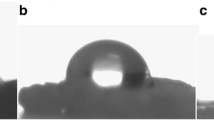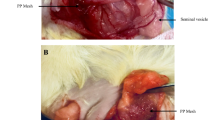Summary
Background
Based on recent data that sperm motility in humans might be (temporarily) affected when lightweight meshes are used for laparoscopic inguinal hernia repair, the aim of this study was to identify the plasticizers present in meshes used for hernia repair.
Methods
Mesh samples (n = 13) were cut into small pieces (1 cm × 1 cm), and, after the addition of internal standard, plasticizers were extracted with hexane:acetone (1:1; v:v) by vortex and ultrasonication. The analysis was performed by gas chromatography and mass spectrometry (GC-MS) in electron ionization mode (EI) with full scan acquisition. The identification of compounds was done by injection of reference standards and using the Wiley mass spectral library.
Results
None of the targeted plasticizers, including phthalates, were present in the analyzed mesh samples. In particular, di-(2-ethylhexyl) phthalate (DEHP), a major phthalate plasticizer frequently used in medical devices in the past, was not detected in any of the samples.
Conclusion
The implantation of mesh materials affecting male fertility, whether temporarily or not, cannot be explained by the presence of the targeted plasticizers, since none of them were found in the wide range of commonly used meshes that were tested in our study.




Similar content being viewed by others
References
Simons MP, Smietanski M, Bonjer HJ, et al. International guidelines for groin hernia management. Hernia. 2018;22(1):1–165.
Baylón K, Rodríguez-Camarillo P, Elías-Zúñiga A, Díaz-Elizondo JA, Gilkerson R, Lozano K. Past, present and future of surgical meshes: a review. Membranes (Basel). 2017;7(3):E47.
Brown CN, Finch JG. Which mesh for hernia repair? Ann R Coll Surg Engl. 2010;92(4):272–8.
Zhu LM, Schuster P, Klinge U. Mesh implants: an overview of crucial mesh parameters. World J Gastrointest Surg. 2015;7(10):226–36.
Sajid MS, Kalra L, Parampalli U, Sains PS, Baig MK. A systematic review and meta-analysis evaluating the effectiveness of lightweight mesh against heavyweight mesh in influencing the incidence of chronic groin pain following laparoscopic inguinal hernia repair. Am J Surg. 2013;205(6):726–36.
Sajid MS, Leaver C, Baig MK, Sains P. Systematic review and meta-analysis of the use of lightweight versus heavyweight mesh in open inguinal hernia repair. Br J Surg. 2012;99(1):29–37.
Currie A, Andrew H, Tonsi A, Hurley PR, Taribagil S. Lightweight versus heavyweight mesh in laparoscopic inguinal hernia repair: a meta-analysis. Surg Endosc. 2012;26(8):2126–33.
Peeters E, Spiessens C, Oyen R, et al. Laparoscopic inguinal hernia repair in men with lightweight meshes may significantly impair sperm motility: a randomized controlled trial. Ann Surg. 2010;252(2):240–6.
Peeters E, Spiessens C, Oyen R, et al. Sperm motility after laparoscopic inguinal hernia repair with lightweight meshes: 3‑year follow-up of a randomised clinical trial. Hernia. 2014;18(3):361–7.
Pant N, Pant A, Shukla M, Mathur N, Gupta Y, Saxena D. Environmental and experimental exposure of phthalate esters: the toxicological consequence on human sperm. Hum Exp Toxicol. 2011;30(6):507–14.
Todros S, Pavan PG, Natali AN. Synthetic surgical meshes used in abdominal wall surgery: part I – materials and structural conformation. J Biomed Mater Res Part B Appl Biomater. 2017;105(3):689–99.
Bilsel Y, Abci I. The search for ideal hernia repair; mesh materials and types. Int J Surg. 2012;10(6):317–21.
Elango S, Perumalsamy S, Ramachandran K, Vadodaria K. Mesh materials and hernia repair. Biomedicine. 2017;7(3):16.
Deeken CR, Lake SP. Mechanical properties of the abdominal wall and biomaterials utilized for hernia repair. J Mech Behav Biomed Mater. 2017;74:411–27.
Onghena M, van Hoeck E, Vervliet P, et al. Development and application of a non-targeted extraction method for the analysis of migrating compounds from plastic baby bottles by GC-MS. Food Addit Contam Part A Chem Anal Control Expo Risk Assess. 2014;31(12):2090–102.
Onghena M, Van Hoeck E, Van Loco J, et al. Identification of substances migrating from plastic baby bottles using a combination of low-resolution and high-resolution mass spectrometric analysers coupled to gas and liquid chromatography. Mass Spectrom. 2015;50(11):1234–44.
Gimeno P, Thomas S, Bousquet C, et al. Identification and quantification of 14 phthalates and 5 non-phthalate plasticizers in PVC medical devices by GC-MS. J Chromatogr B Analyt Technol Biomed Life Sci. 2014;949–950:99–108.
Tekatli H, Schouten N, van Dalen T, Burgmans I, Smakman N. Mechanism, assessment, and incidence of male infertility after inguinal hernia surgery: a review of the preclinical and clinical literature. Am J Surg. 2012;204(4):503–9.
Marie C, Vendittelli F, Sauvant-Rochat MP. Obstetrical outcomes and biomarkers to assess exposure to phthalates: a review. Environ Int. 2015;83:116–36.
Pant N, Shukla M, Kumar Patel D, et al. Correlation of phthalate exposures with semen quality. Toxicol Appl Pharmacol. 2008;231(1):112–6.
Silva MJ, Reidy JA, Preau JL, Samandar E, Needham LL, Calafat AM. Measurement of eight urinary metabolites of di(2-ethylhexyl) phthalate as biomarkers for human exposure assessment. Biomarkers. 2006;11(1):1–13.
Latini G, Scoditti E, Verrotti A, De Felice C, Massaro M. Peroxisome proliferator-activated receptors as mediators of phthalate-induced effects in the male and female reproductive tract: epidemiological and experimental evidence. PPAR Res. 2008; https://doi.org/10.1155/2008/359267.
Koch HM, Preuss R, Angerer J. Di(2-ethylhexyl)phthalate (DEHP): human metabolism and internal exposure—an update and latest results. Int J Androl. 2006;29(1):155–65.
Wittassek M, Koch HM, Angerer J, Brüning T. Assessing exposure to phthalates—the human biomonitoring approach. Mol Nutr Food Res. 2011;55(1):7–31.
Thurston SW, Mendiola J, Bellamy AR, et al. Phthalate exposure and semen quality in fertile US men. Andrology. 2016;4(4):632–8.
Jenardhanan P, Panneerselvam M, Mathur PP. Effect of environmental contaminants on spermatogenesis. Semin Cell Dev Biol. 2016;59:126–40.
Jones HB, Garside DA, Liu R, Roberts JC. The influence of phthalate esters on Leydig cell structure and function in vitro and in vivo. Exp Mol Pathol. 1993;58(3):179–93.
Wirth JJ, Rossano MG, Potter R, et al. A pilot study associating urinary concentrations of phthalate metabolites and semen quality. Syst Biol Reprod Med. 2008;54(3):143–54.
Verstraete S, Vanhorebeek I, Covaci A, et al. Circulating phthalates during critical illness in children are associated with long-term attention deficit: a study of a development and a validation cohort. Intensive Care Med. 2016;42(3):379–92.
Acknowledgements
The table was compiled with the product information received by each company.
Authors’ Contributions
Study conception and design: Van De Winkel, Yurtkap, Van Schepdael, Miserez
Acquisition of data: Van De Winkel, Yurtkap
Analysis and interpretation of data: Malarvannan, Covaci, Van De Winkel
Drafting of manuscript: Van De Winkel, Dhooghe
Critical revision and approval final manuscript: all authors
Author information
Authors and Affiliations
Corresponding author
Ethics declarations
Conflict of interest
N. Van De Winkel reports personal fees from Lifebond. M. Miserez reports personal fees from Springer, grants and personal fees from BARD, grants from Duomed, personal fees from Lifebond, personal fees from Medtronic, outside the submitted work. Y. Yurtkap, V. Dhooghe, S. Huang, G. Malarvannan, G. Van den Mooter, A. Covaci, and A. Van Schepdael declare that they have no competing interests.
Additional information
Publisher’s Note
Springer Nature remains neutral with regard to jurisdictional claims in published maps and institutional affiliations.
Rights and permissions
About this article
Cite this article
Van De Winkel, N., Yurtkap, Y., Dhooghe, V. et al. Phthalates and infertility: an issue in hernia meshes?. Eur Surg 52, 210–216 (2020). https://doi.org/10.1007/s10353-020-00636-1
Received:
Accepted:
Published:
Issue Date:
DOI: https://doi.org/10.1007/s10353-020-00636-1




